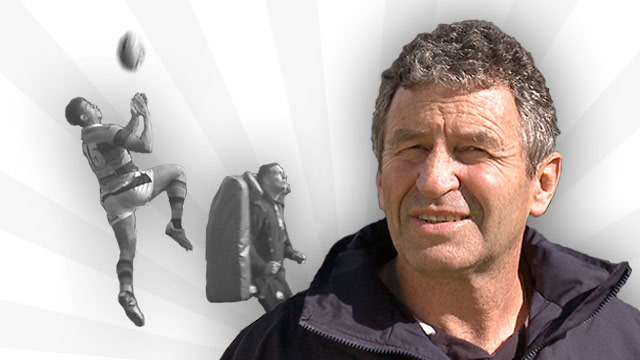“Contesting your own high ball” – Wayne Smith module
Kicking to contest possession from positions further upfield than the exit zone (approximately 0-25 metres from your own goal-line) has been an increasingly common theme in top level rugby over the past few years.
New Zealand kick-started the trend a few years ago, and both Joe Schmidt’s Ireland and Warren Gatland’s Wales have taken up the torch with enthusiasm in the Northern Hemisphere. Eddie Jones’ England increased the premium on high contestable kicking further in their 2016 Six Nations victory.
The basic idea, as Wayne Smith points out in his coaching module*, is to create that precious commodity – turnover ball – at a situation other than the defensive breakdown. With turnover ball you can employ your offensive skill-sets to maximum effect against a relatively disorganised or unstructured defence – the ideal attacking scenario.
The turnover can be created one of two ways: either
1. by retrieving the ball directly in the air over the opposition receiver, or
2. by manipulating the receiver in contact after the ball has been caught.
The following examples derive from games played by the Highlanders in this year’s Super Rugby competition, and England in the Six Nations earlier this year.
The first instance comes from the Highlanders-Waratahs match (at 45:55), two teams who contested one of the 2015 Super rugby semi-finals. The Highlanders kicked 35 times in that game, and manipulation of the Tahs’ backfield was a definite tactic for them. Nothing much had changed one year later! Key points are as follows:
• Upfield position & the mismatch outside. The Highlanders are prepared to launch the kick from as far upfield as the 40m line of the Waratahs when the perceived weakness against the kicking game is there. Here Lima Sopoaga puts up a perfectly-weighted kick out to the right, where the main two chasers – 6’5” loose forwards Elliot Dixon and Liam Squire, are matched up on two 6’ backs in the shape of wing Zack Guildford and 2nd five-eighth David Horwitz. If the kick is accurate, there will be a clear advantage in the contact situation to follow for the Highlanders.
• Use of “J lines” into the contest & receiving technique. As the kick is in mid-air at 45:58, both chasers observe a nice “J shape” into the contact, as Wayne Smith emphasizes early in his module. Dixon chases along the 5m line with Squire parallel to, and just inside the 15m line. This enables them to observe the ball in flight while avoiding the potential blocker Horwitz. At 45:59, both complete the “J” by converging on the receiver Guildford.
• Elliot Dixon aerial contest technique. When Dixon reaches the point of contact, he turns into the pathway of the ball from his “J-Line” and gets a powerful vertical leap off his inside leg. As Wayne Smith suggests he has a high leading knee into contact at 45:59:

At the key moment, Dixon is well above Guildford and much closer to the apex or high point of his jump in the air. With Guildford as the last defender in the Tahs’ backfield, it is an easy canter in for the try once Dixon has caught the ball.
The second example comes from the Six Nations 2016 game between England and Italy (at 43:45). It illustrates how the receiver can be manipulated to create turnover potential after he has made the receipt.
Key points are as follows:
• Anthony Watson and the ‘judo throw’. Once again there are two main chasers running along the 5m (Antony Watson) and 15m lines (Chris Robshaw) after George Ford makes the diagonal high kick. If anything, Watson loses his “J-line” into the catcher (Luke McLean) slightly early so that initially, he loses the ball in flight and runs past the point of contact. As a result, after the receipt the judo throw is more of a rear pick-up throw than a hip toss.

The end-product tallies with Wayne Smith’s coaching module: Watson is able to get up off the ground as the tackler in an advanced position. His body is in between the first Italian support player (Leonardo Sarto) and the ball and Watson is able drive him out of the play.
• Targeting the receiver’s support. England #2 Dylan Hartley helps Watson drive off Sarto, while Chris Robshaw targets the only other Italian support close enough to help – #9 Eduoardo Gori – at 43:53. One second later, the only two Italian players who could have prevented the turnover are either on the ground or away from the ball.
• The embryonic “L” shape. The other key Wayne Smith recommendation – that support players should cycle back into space before running forward on to the ball to promote the counter-attack – is illustrated by the actions of England #1 Mako Vunipola at the end of the clip. At 43:53 Vunipola is running toward the site of tackle with his shoulders angled towards touch; as soon as he sees the ball is won, he pulls out and squares his shoulders down the field to become an attacker on the next play.
Summary: These two examples provide excellent support to the two methods of contesting the high kick Wayne Smith describes in his module. In the first, Elliot Dixon demonstrates the accuracy required in pursuit lines, approach to the ball and vertical leap phases to win the ball directly. In the second, England show how to win turnover via the ‘judo throw’ by the first chaser to get top position over the ball, the effective targeting of the receiver’s support to win it, and the ‘lean’ or economic action of potential counter-attackers on the next phase.


